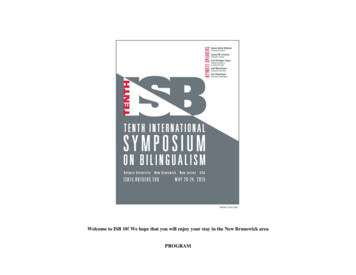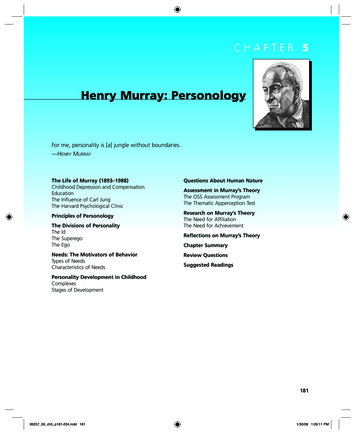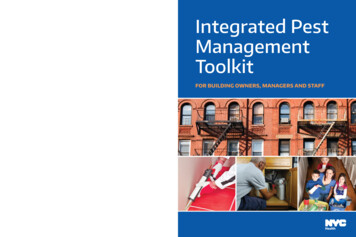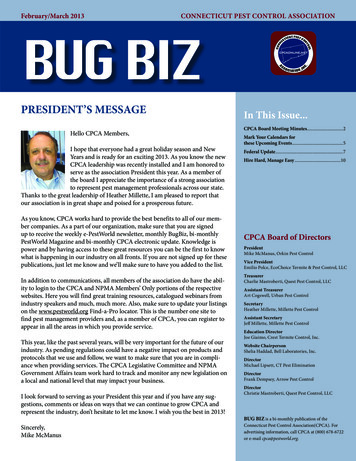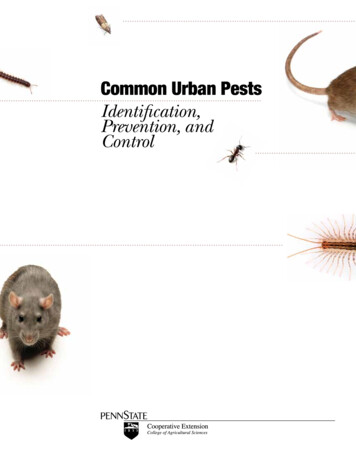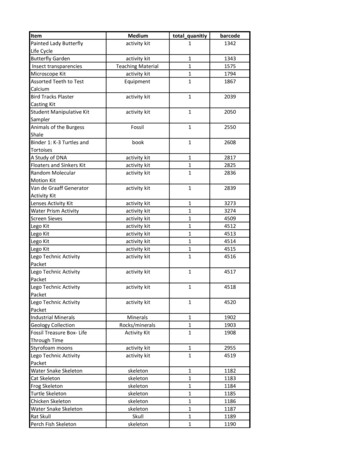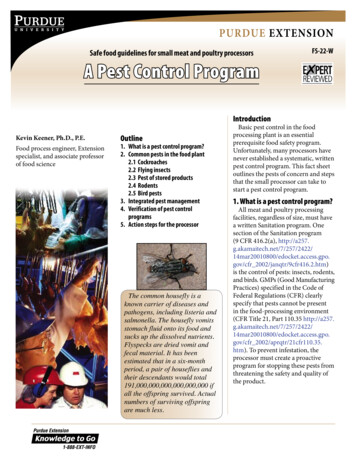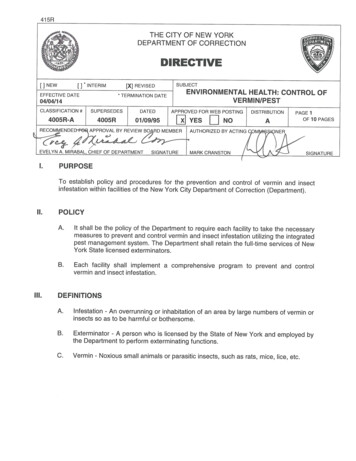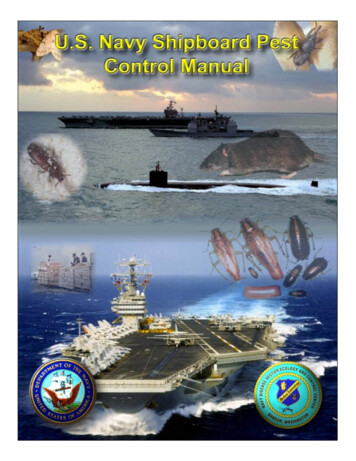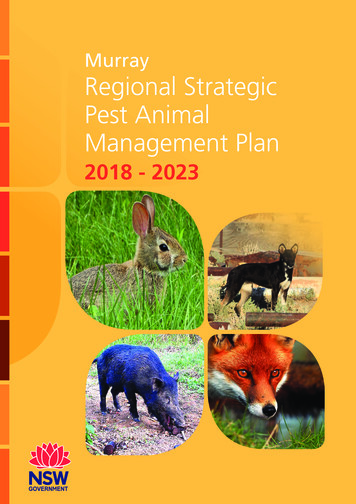
Transcription
MurrayRegional StrategicPest AnimalManagement Plan2018 - 2023
Published by Murray Local Land ServicesMurray Regional Strategic Pest Animal Plan 2018-2023First published May 2018 www.lls.nsw.gov.au/murray State of New South Wales through Local Land Services, 2018.Disclaimer: The information contained in this publication is based onknowledge and understanding at the time of writing in May 2018.However, because of advances in knowledge, users are reminded of theneed to ensure that information upon which they rely is up to date andto check currency of the information with the appropriate officer of LocalLand Services or the user’s independent adviser.
Murray I Regional Strategic Pest Animal Management PlanContentsMinister's Foreword . 2Executive Summary . 31. Introduction. 41.1 Overview . 41.2 Purpose of the plan . 41.3 What is considered a pest animal? . 41.4 Managing native animals . 51.5 Framework for pest animals. 51.6 Roles and responsibilities . 61.7 Incursion management and alert species. 72. Guiding principles of pest animal management. 83. Our region . 94. Managing our pest animals. 105. Our priority pest species. 115.1 Species - European fox. 125.2 Species - Feral cat . 135.3 Species - Feral goat. 145.4 Species - Feral pig.155.5 Species - Wild deer . 165.6 Species - Wild dog. 175.7 Species - Wild horse . 185.8 Species - Wild rabbit. 195.9 Species - Common carp . 205.10 Species - Watch list species (house mouse). 206. Measuring success and continuous improvement . 216.1 Key performance indicators . 216.2.1 Statewide KPIs . 216.2.2 Species KPIs . 226.2 Measuring performance. 246.3 Plan review . 247. The Biosecurity Act . 258. Further information. 26Appendix 1: Prioritisation Process. 271
Murray I Regional Strategic Pest Animal Management PlanMinister's ForewordI am pleased to announce the Murray Regional Strategic Pest Animal Management Plan. This plan is a vital communitytool, as it provides a strategic regional approach to improving the coordination and delivery of on ground, nil tenurepest animal management activities for terrestrial vertebrate and freshwater aquatic pest species in NSW.The Murray Regional Strategic Pest Animal Management Plan is an excellent example how local communities canwork together to protect the environment, community and economy from the negative impacts of pest animals andto support positive outcomes for our landscapes and ensuring we maintain a bio-secure environment.The Murray Regional Strategic Pest Animal Management Committee represents major land uses and relevanteconomic, environment and community representatives for each region. The committee delivers a collaborativeapproach to setting regional priorities and is integral to the ongoing effective delivery of pest animal managementoutcomes in the region.This plan is a product of extensive collaboration and engagement across numerous stakeholders involved in pestanimal management. It will continue to grow and evolve with the changing environment and is an excellentframework to contribute to the delivery of improved coordinated pest animal management in NSW.The Hon. Niall Blair MLC Minister for Primary Industries, Minister for Regional Water, and Minister for Trade andIndustryPhoto credit: Paul Meek 2
Executive SummaryThe Murray region is impacted by a number of pest animal species that require coordinated and targeted control.This plan has been prepared by the Murray Regional Pest Animal Management Committee, a sub-committee ofMurray Local Land Services with membership representing farmers, the community, environmental groups andgovernment land managers.The overall goals of the plan are to: reduce the impacts of pest animals within the Murray region on production, the environment and thecommunity improve community engagement and expertise in pest animal management improve monitoring and reporting of pest animal management activities.A uniform prioritisation process was used across the state to assess the management category of each pest specieswithin local regions (refer Appendix 1).The pest species prioritised for action within the Murray Region are: European fox Wild dog Feral cat Wild horse Feral goat Wild rabbit Feral pig Common carp. Wild deerSpecies that do not occur in the region that may be likely to establish in the region have been identified as ALERTSPECIES requiring immediate reporting and eradication. These species are: Chital deer Hog deer Rusa deer American corn snake Red-eared slider turtle Mozambique tilapia.Local management plans will be a major tool used to improve coordination of pest animal management activitieswithin the region. Plans will be implemented where individual species are presenting a high risk to agricultural, socialor environmental assets and will be created in conjunction with affected stakeholders. They will contain specific,achievable, measurable and timely outcomes. Plans may target one or more species within defined sub-regional areasand will outline best practice control activities that will allow local land managers to meet their General BiosecurityDuty whilst reducing the overall impact of the pest across the local plan area.3
1. Introduction1.1 Overview The Murray Regional Strategic Pest Animal Management Plan (RSPAMP) outlines how Government, industryand the community can work together and share the responsibility to eradicate, contain or manage pestanimals in terrestrial and freshwater aquatic environments across the region The economic impact of wild rabbits, carp, pigs, foxes, dogs, goats and introduced birds has been estimatedat 170 million in NSW. Under the NSW Biosecurity Act 2015, all community members have a general biosecurity duty to prevent,minimise or eliminate any biosecurity risk. The general biosecurity duty is a principle that can be used by thecommunity, landholders, Government and industry to implement best practice behaviours to achieve effectivepest animal management.1.2 Purpose of the planThe overall purpose of the RSPAMP is to work together to protect the environment, community and economyfrom the negative impacts of pest animals to support positive outcomes for biosecurity and sustainable landscapes.The plan supports regional implementation of the NSW Biosecurity Act 2015 and NSW Biosecurity Strategy and isreflective of key aligning themes including: Improved community engagement in biosecurity management Improved identification, diagnostic, surveillance, reporting and tracing systems for pests, diseases and weeds. Increased numbers of well trained and resourced peopleThis plan is one of 11 RSPAMPs across NSW. It presents a clear vision by identifying regional priorities for pest animalmanagement and outlines how Government agencies, community groups and individual landholders will shareresponsibility and work together across land tenures to prevent, eradicate, contain and manage the impacts of pestanimals.RSPAMPs will provide guidance on how both public and private land managers can meet their general biosecurity dutyand identify key commitments for pest animal management activities over the life of this plan.1.3 What is considered a pest animal?Under the NSW Biosecurity Act 2015, pest animals are not defined by species. Pest species can be considered as anyspecies (other than native species) that present a biosecurity threat.Whilst the Act does not define pest animals, there are specific activities that are permitted under the Biosecurity Order(Permitted Activities) that would otherwise be prohibited (such as keeping exotic animals in captivity).It is the responsibility of individuals to ensure they discharge their general biosecurity duty to manage the biosecurityrisks posed by pest animals. The Biosecurity Regulation 2017 will outline mandatory measures for pest animalmanagement in NSW. General control and management of pest animals outlined in this plan can be consideredmechanisms for individuals to discharge their general biosecurity duty and landholders and community membersshould work with stakeholders identified for ongoing implementation of pest animal management practices.4
Murray I Regional Strategic Pest Animal Management Plan1.4 Managing native animalsNative species are protected by law in NSW and are not covered in this RSPAMP. Issues associated with managingthe impacts of native species (such as kangaroos, emus, wombats and possums) should be addressed separatelyin consultation with National Parks and Wildlife Service and having regard to the regulatory requirements of theBiodiversity Conservation Act 2016. Non-lethal methods may include exclusion netting, fencing, gating, and olfactorydevices. Where it is necessary to use lethal methods such as shooting to destroy native animals because they are athreat to human safety, damaging property and/or causing economic hardship, the National Parks and Wildlife Servicecan issue a biodiversity conservation licence to harm protected native animals under the Biodiversity Conservation Act2016.For further information visit /OccupierLicences.htm1.5 Framework for pest animalsFigure 1. The NSW Biosecurity framework for pest animals in NSWNATIONALNSWNational BiosecurityCommitteeMinister for PrimaryIndustriesBiosecurity AdvisoryCommitteeIntergovernmentalAgreement onBiosecurityNational EnvironmentalBiosecurity ResponseAgreementBiosecurity Act 2015NSW Biosecurity StrategyNSW Invasive Species PlanLocal Land Services strategic plans Local Land Services State Strategic Plan Local Land Services Local Strategic PlanVERTEBRATEPEST ANIMALSState Pest AnimalCommitteeSpecies specific strategiesRegional Pest AnimalCommitteesRegional Strategic Pest Animal Management Plans NSW Wild Dog Management Strategy NSW Wild Deer Management StrategyLocal management plans developed with participationand agreement by those land managers, groups andorganisations that will implement the planSpecific vertebrate pest animal incursion response5
Murray I Regional Strategic Pest Animal Management Plan1.6 Roles and responsibilities Under the new Biosecurity Act 2015 framework, biosecurity is a shared responsibility where Government,industry and the people of NSW work together to protect the economy, environment and community fromthe impacts of pest animals. Public, private and aboriginal land managers all have a shared and equal responsibility to eliminate andminimise biosecurity risks across land in NSW. A key focus of the RSPAMP is to encourage engagement and participation across all land tenures to enhancethe participation and delivery of coordinated pest animal management activities for improved outcomes. Government plays a key role in coordination and regulation for pest animal management under the legislativeframework. NSW DPI have a lead role in managing terrestrial and freshwater aquatic pest incursions. LocalLand Services supports the delivery of pest animal management activities and also have a regulatory role underthe NSW Biosecurity Act 2015.The following outlines the role of the Regional and State Pest Animal Committee in the delivery of the RSPAMP.For more information on key roles and responsibilities in pest animal management, please refer to the Invasive SpeciesPlan 2018-2021.State Pest Animal CommitteeThe State Pest Animal Committee (SPAC) is responsible for overseeing a consistent approach to the ongoingoperation of RPACs and development of tenure neutral RSPAMPs across the State. SPAC oversee key policy andstrategy documents to guide pest animal management outcomes across the state.Regional Pest Animal CommitteesRegional Pest Animal Committees (RPACs) facilitate tenure neutral strategic planning and coordination for prioritypest animal management programs in each Local Land Services (LLS) region. RPACs have an important role to playin the delivery of the RSPAMP through promoting land manager and general community involvement in detectingand reporting sightings of new or ‘unusual’ animals in the local area as well as managing established pest animals.RPACs play an important role in the ongoing periodic review and adaption of the plan as required.1.7 Incursion management and alert speciesWe need to work together to ensure early detection and awareness of incursions and alert species are able to bemanaged swiftly and effectively. It is important the community remain vigilant and report any unusual sightings toensure a rapid management response.The NSW Biosecurity Act 2015 outlines species that are prohibited from being kept in NSW.Land managers and community members play a major role in reporting any unusual sightings of pest animals in theregion.6
ALERT SPECIES FOR THE MURRAY REGIONIf you see any of the species listed below or any other unusual animals, please contact the Invasive Plants andAnimals Enquiry line: 1800 680 244. Chital deer Hog deer Rusa deer American corn snake.If you see any of the species listed below or any other unusual aquatics, please contact the Aquatic Pests andDiseases Hotline: 1800 675 888 or email aquatic.pests@dpi.nsw.gov.au. Red-eared slider turtle Mozambique tilapia.Top row (l-r): Chital deer, hog deer, rusa deer.Bottom row (l-r): American corn snake, red-eared slider turtle, Mozambique tilapia.Photographs courtesy NSW Department of Primary IndustriesThe following mechanisms can be used to report unusual situations in the region: Invasive Plants and Animals Enquiry Line: 1800 680 244For species that are yet to become widely established in NSW, the initial response to incursion reports is managedthrough consultation between DPI, Local Land Services and OEH. Where species are widely established in NSWbut have spread into a new region, Local Land Services and the RPAC will consider whether local eradication orcontainment should be attempted.7
2. Guiding principles of pest animalmanagementThe following principles should be considered and implemented by all community, industry, landholdersand other stakeholders in pest animal management.Be alertMonitor and report sightings of any species you have not seen in your area before. Prevention and earlyintervention from the community is important to avoid the establishment of new pest animal species.Work together and participatePest animal management is a shared responsibility between landholders, community, industry and Governmentand requires a coordinated approach across a range of scales and land tenures.Be committedEffective pest animal management requires ongoing commitment by land managers, community, Governmentand industry. Those that create the risks associated with pest species and those that benefit from the pest animalmanagement outcomes should help to minimise impacts and contribute to the costs associated with managementStay up-to-dateCommunity, industry, government and landholders should stay up-to-date with new information to ensure thatcontemporary best practice pest animal management activities are employed to reduce pest animal impacts in away that is as safe, effective, target-specific and humane as possible.8
Murray I Regional Strategic Pest Animal Management Plan3. Our regionThe NSW Murray Local Land Services region covers a land surface area of over 42,000 km2. Bordered by the MurrayRiver in the south, the region’s landforms and vegetation communities range from Australia’s highest alpine peaks andslopes, forests, and grassy woodlands and grasslands of the South West Slopes region to the semi-arid woodlands andvast grasslands and scrublands of the Riverina Plains.Agricultural industries are diverse, including irrigated and dryland cropping, livestock grazing, and dairy production,with an estimated one-third of the region’s community involved directly in agricultural enterprises. Extensive irrigationnetworks and the Snowy Hydro-Electric Scheme supply water to low rainfall areas. The region contains significantenvironmental assets such as the Central Murray state forests Ramsar sites.Factors that currently influence pest animal management within the Murray region include restricted resourcesavailable for pest management, changes in farming practices (grazing to cropping), absentee land managers andsmall-scale farms, urban areas and public places with limited control options. Management of wild deer and feral catsis limited by a lack of control methods currently available for these species.The Murray region borders Riverina, Western and South Eastern Local Land Services regions as well as Victoria.Inter-regional co-operative programs are already in place for wild dogs (annual aerial baiting program) and feral pigs(Western Riverina Feral Pig Program) with both the Riverina and Western regions. While the Great Dividing Rangeand the Murray River present significant physical barriers to the South East region and Victoria, local managementplans bordering these areas will consider possible cross-boundary pest management in conjunction with relevantstakeholders and agencies. The existing tristate partnership, comprising NSW, Victorian and South Australian regionalnatural resource management organisations, provides an excellent vehicle for inter-state cooperation on emergingcross-border pest animal issues e.g. Common carp control developments.Murray Local Land Services regionThe pest animal distribution maps in this planare based on statewide data compiled in 2016from reports submitted and gathered. Themaps are at a coarse scale and provide generalguidance only about pest animal distribution.A key priority for future implementation of thisplan will be to improve reporting of pest animalsto refine regional information collected on pestanimal distribution and relative abundance.Improved information on distribution andabundance will better guide management andinvestment and assess effectiveness9
Murray I Regional Strategic Pest Animal Management Plan4. Managing our pest animalsThe following section details the management categories that should be used to minimise and mitigate the impactpest animals have on the community, environment and primary industries.Pest animals in Murray region have been prioritised based on this framework.Management CategoryOverview GOAL: To prevent the pest animal species arriving and establishing in the Regioncausing adverse impacts on the environment, society and the economy. RESPONSIBILITY: To understand and report any sightings of alert species. GOAL: To permanently remove the species from the State or Region and todevelop actions to prevent its re-establishment. RESPONSIBILITY: To participate in coordinated programs and stayup-to-date with current information on pest animals in the region. GOAL: To prevent the spread of the pest animal species onto other parts of theState or Region. RESPONSIBILITY: To participate in coordinated programs, stayup-to-date and apply best practice pest animal management practices. GOAL: To reduce the impact of widespread pest animals on key assets with higheconomic, environmental and social value. RESPONSIBILITY: To participate in coordinated programs, stayup-to-date and apply best practice pest animal management practices. Ensurepractices are coordinated with the wider community. GOAL: Applies only to species that have a low to negligible risk in the region orfor which further investigation is required on effective control techniques andstrategies for management. RESPONSIBILITY: Stay up-to-date with current Asset Based ProtectionLimited ActionFurther reading and best practice guidelines for pest animal management may be foundat:PestSmart Connect (by Centre for Invasive Species Solutions)https://www.pestsmart.org.auNSW Department of Primary ide-manualMeat and Livestock ive-animalsAustralian Wool Innovation est-animals10
5. Our priority pest speciesPest animals for the Murray region have been prioritised based on level of risk and feasibility of control assessedthrough prioritisation guidelines using the South Australian prioritisation tool.Priority species listed below have been categorised into management categories and further strategies and actions aredetailed.Table 1.1: Species listed in this plan.Common NameManagement CategoryEuropeanfoxAsset based protectionFeral catAsset based protectionSectionin Plan5.1Reduce the impacts of foxes on agricultural production andcritical threatened species.Prevent the spread of disease.5.2Reduce the impacts to critical threatened species, sites to beidentified in localised project plans.Reduce the impacts to agricultural production.Promote responsible pet ownership.Containment – AlburyCity Council localgovernment areaFeral goatFeral pigAsset-based protection –excluding the Albury CityCouncil local governmentareaAsset based protectionObjective5.3Reduce the impacts of feral goats on agriculturalproduction, threatened species and ecological communitieswithin the Albury City Council local government area.Reduce the impacts of feral goats on agricultural productionand the environment.5.4Reduce the impacts of feral pigs on agricultural production,threatened species and ecological communities.Prevent the spread of disease.Prevent further establishment of all wild deer species.Wild deerAsset-based protectionWild dogAsset-based protection- east of the Humehighway5.55.6Reduce the impacts of wild deer on agricultural production,threatened species and ecological communities.Reduce the impacts of wild dogs on agricultural production eastof the Hume highway.Ensure current wild dog management plans are in place.Eradication - west of theHume highwayEradicate.Wild horseAsset-based protection5.7Land managers to manage wild horses in line with theircurrent wild horse management plans, policies and/orobjectives to reduce impacts on agricultural production, theenvironment, threatened species and/or public safety.WildrabbitAsset based protection5.8Reduce the impacts of rabbits on agricultural production,threatened species and ecological communities and culturalheritage.CommoncarpLimited action5.9Support coordinated biological control programs.HousemouseWatch list5.10Monitor numbers and promote best practice control11
5.1 Species - European foxEuropean foxes are widespread across the Murray region.As an established species that impacts on agriculturalproduction and conservation lands, land managersshould take all reasonable steps to suppress and destroythe population. Coordinated group fox baiting programsare well established within the Murray region. Theseprograms provide land managers with technical support,training, access to fox baits and advice on best practicecontrol options for fox populations.European foxBarriers to effective control of fox populations are:changes in farming practices (grazing to cropping),absentee land managers, landholding aggregation, urbanareas (public places - limited control options).Major sheep-producing areas, Ramsar wetlands and othersites with significant environmental and cultural heritagewill be prioritised for assessment of the need for thedevelopment of local management plans.ObjectiveReduce theimpacts onagriculturalproductionand criticalthreatenedspeciesReduce therisk of thespread ofdiseaseIncreasethe numberof in tegoryMurrayregionAsset basedprotectionAssets(whererelevant)Murray Local Land Services (2018). Pest distribution animal data hasbeen sourced from NSW Government agencies and collated by theNSW Department of Primary Industries in 2016.ActivitiesParticipantsTimeframeLivestock –sheep, goats,farmed enedspeciesPrimaryGround baitingFox exclusionfencingPrepare andimplement local foxmanagement plansLand managersFox baiting groupsCommunity basedgroupsLocal Land ServicesAutumn &spring eachyearOngoingSupplementaryGround shootingLand managersOngoingImprovecommunityparticipationin key areasTargetedcommunicationsE-newslettersMedia coverageSocial mediaCommunitymeetingsLand managersLocal Land ServicesCommunity basedgroupsOngoing
Murray I Regional Strategic Pest Animal Management Plan5.2 Species – Feral catFeral cats are established and widespread across theMurray region. The species poses significant risk to theenvironment and the potential for disease transmissionto livestock. Feral cats have been identified as a specieswarranting coordination with local government toprogress control strategies.Feral catThe aim of the plan is to raise awareness of the impactsof feral cats on the environment, to work collaborativelywith stakeholders to implement effective cat controlprograms and to encourage the community to embraceresponsible cat ownership.Community engagement, surveillance and reportingwill be key focus areas for future feral cat management.The restricted number of control methods availableis a significant limiting factor to effective feral catmanagement.ObjectiveReduce theimpactsto criticalthreatenedspecies.Reduce theimpacts toagriculturalproductionIncrease theawareness ofthe negativeimpacts of feralcatsImproveresponsible petownershipMurray Local Land Services (2018). Pest distribution animal data hasbeen sourced from NSW Government agencies and collated by theNSW Department of Primary Industries in 2016.Programname/areaManagementcategoryAssets vestock(farmed birds,small ppingExplore newmanagementoptionsAdvocate fornew targetedcat toxinsExclusionfencingLand managersFeral catmanagement groupmembersLocal gove
The Murray region is impacted by a number of pest animal species that require coordinated and targeted control. This plan has been prepared by the Murray Regional Pest Animal Management Committee, a sub-committee of Murray Local Land Services with membership representing farmers, the community, environmental groups and government land managers.
